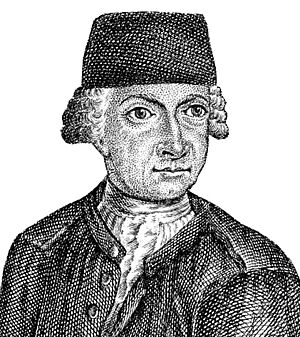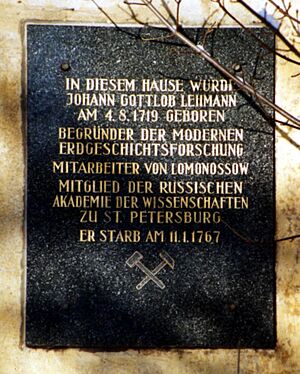Johann Gottlob Lehmann (scientist) facts for kids
Quick facts for kids
Johann Gottlob Lehmann
|
|
|---|---|

Lehmann in the age of 42
|
|
| Born | 4 August 1719 Langenhennersdorf, Electorate of Saxony
|
| Died | 22 January 1767 (aged 47) |
| Nationality | German |
| Alma mater | University of Wittenberg |
| Known for | Stratigraphy |
| Scientific career | |
| Fields | Mineralogy |
Johann Gottlob Lehmann (born August 4, 1719 – died January 22, 1767) was a clever German scientist. He was a mineralogist, someone who studies minerals. He was also a geologist, meaning he studied the Earth's rocks and how they formed. Lehmann is well-known for his important work on the geologic record. This is like the Earth's history book, written in layers of rock. His research helped create the science of stratigraphy, which is the study of these rock layers.
Early Life and Scientific Journey
Johann Gottlob Lehmann was born in a place called Langenhennersdorf, in what was then the Electorate of Saxony. This area is now part of Germany. He went to the University of Wittenberg and earned a medical degree in 1741. After finishing his studies, he started working as a doctor in Dresden.
While living in Saxony, Lehmann became very interested in the local mining industry. He began to study the chemical makeup of ore deposits. Ores are rocks that contain valuable metals or minerals. In 1750, a group called the Royal Prussian Academy of Sciences asked him to travel around Prussia. His job was to study how mining was done in different places.
Discoveries and Contributions
In 1761, the Russian Imperial Academy of Sciences invited Lehmann to move to Saint Petersburg, Russia. There, he became a professor of chemistry. He also became the director of the imperial museum. This was a big honor!
One of his most exciting discoveries happened in the Ural Mountains. At a place called the Beryozovskoye deposit, he found a special kind of lead ore. It had a reddish-orange mineral in it. He named this mineral "Rotbleierz," which means "red lead ore" in German. Today, we know this mineral as crocoite.
Lehmann, along with two other scientists named Georg Christian Füchsel and Giovanni Arduino, are considered the founders of stratigraphy. This science helps us understand the order of rock layers. Lehmann was very good at describing these layers. He called them "stratified rocks" or Flötzgebirge.
He studied the rock layers in a region called Ilfeld and Mansfeld. He found and described thirty different layers of rock there. He even drew diagrams and sections to show how the layers were arranged. Many of the words he used to describe these rocks came from miners. These words are still used in geology today. For example, Zechstein is a type of rock layer. Another term he used was rothes Todtliegendes, which means "red underlayer." This refers to the unproductive rock layers found below the valuable ore.
Johann Gottlob Lehmann passed away in Saint Petersburg. He died due to an accident in his laboratory while working with chemicals.
Images for kids



